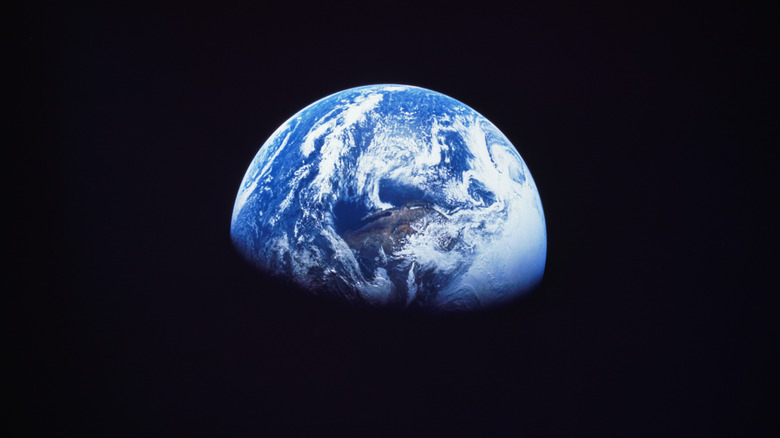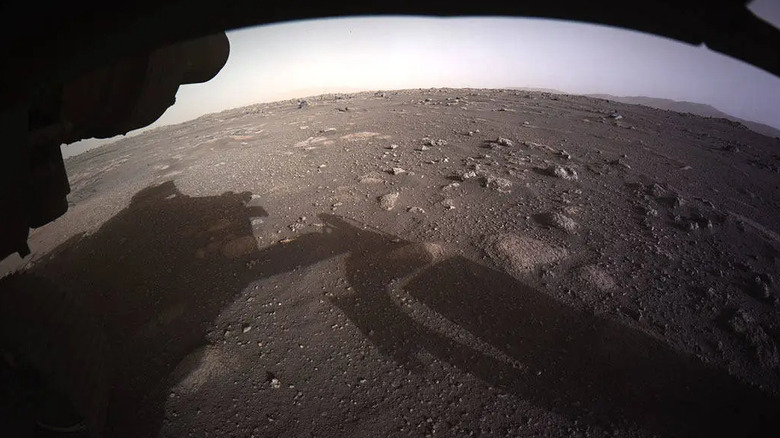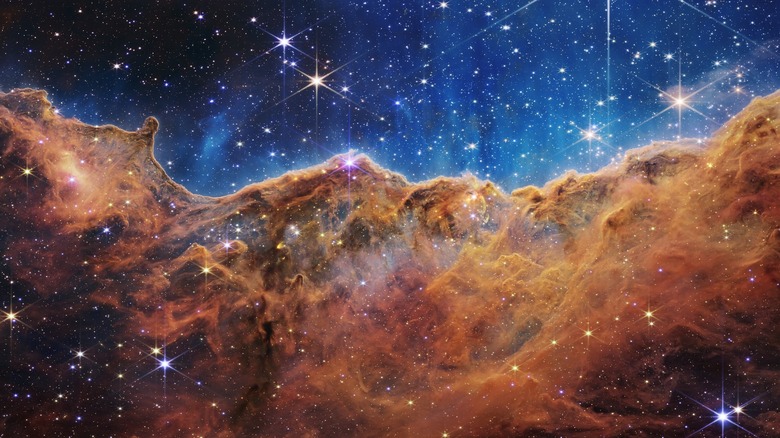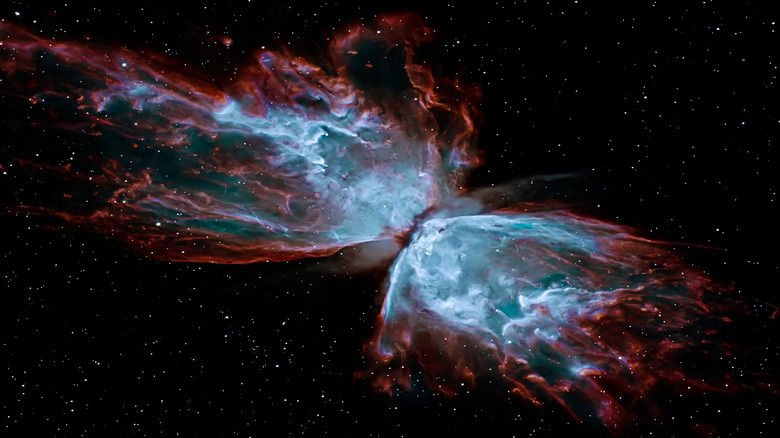The Real Reason NASA Frequently Alters Its Photos
NASA certainly does present an easy target for the conspiratorially-minded. After all, in an age where every single basic fact seems disputed — especially of the scientific variety — not too many people can verify information about space, the moon, other galaxies, etc., firsthand. We've got to rely on experts like NASA that have access to exclusive knowledge and devices like the James Webb Space Telescope (JWST). This comes as a blow to some egos, and gives us fruitless conversations about the 1966 moon landing being faked or absurd claims about Earth being flat.
There are plenty of other NASA-related conspiracies tossed about in certain circles, like about NASA doctoring their photos of space, especially when it comes to colors. The colors of far-flung nebulae are too vibrant, some say. They're unrealistic. Nothing looks like that. Space object x, y, z wouldn't look like that if you looked at it with your own eyes, etc., etc.
That last point is exactly the point. You can't see a nebula with your own eyes — you see it through a telescope. Telescopes like the Hubble process mountains of data into composites that necessitate filtered colors. Those colors are different in space and in other atmospheres like Mars because of dust, glare, heat, and so forth. Plus, telescopes like the JWST see infrared light that the human eye can't see, and it needs to be converted into something visible. In other words, every photo of space needs to be adjusted in some way, and they've never tried to hide it.
Mars, the gray planet?
Mars: Our closest planetary neighbor and home to red dunes and barren red rock. Or is it yellowish-brown dunes and rock? Or grayish-blue? Well, that's just it: No human has ever been to Mars, so there's no default "correct" Martian landscape colors. Humans see green, blue, yellow, red — whatever — through Earth's atmosphere and light. And even then, colors change depending on the amount of light, atmospheric haze, the individual eyes of the viewer, etc. And fun fact: NASA's Martian rovers aren't equipped with human eyes.
Looking at raw, calibrated, and white balanced photos side by side illustrates this point perfectly — a point that explains how and why NASA alters photos. Raw photos are unprocessed versions similar to the amassed data of digital cell phone pictures. Images taken by the Mars Curiosity rover, for example, appear yellowish. But those colors aren't what Mars would look like to a person on Mars. For that we look to the calibrated photos, which show a redder version of the planet. But it's the white balanced pictures — a term that should be familiar to photographers, video editors, and Photoshop users — that produce the sharpest photos because they adjust all colors in reference to true white. This makes the images look the closest to an Earth-like illumination. Which is the "correct" photo? All of them. Other raw NASA photos from the Mars rover Perseverance, it should be noted, are completely gray.
To see what can't be seen
NASA launched the James Webb Space Telescope (JWST) on Christmas Day, 2021, the product of over 30 years worth of planning, 10 billion dollars, collaboration between NASA, the European Space Agency (ESA), and the Canadian Space Agency (CSA), and the engineering brilliance of some of Earth's finest minds. The JWST was designed to peer through time — that is, to see as far into the past as possible to light that took billions upon billions of years to reach us. To do so the JWST focuses on infrared light — not visible light — which is invisible to the human eye. So if the JWST takes photos of infrared light, how can we see anything? Easy: NASA builds the photos.
We could use a lot of examples for this point, but the JWST's pictures make the easiest, strongest case. The telescope's raw photos are practically empty, get transformed into black and white shots, and then receive color correction. Because each image contains an immense amount of data, the alteration process is highly painstaking and involves some serious software. Not only can we see what's otherwise invisible as a result, but the JWST also allows us to see directly through objects that would appear opaque to other telescopes because infrared light passes more easily through gas and dust. This is what allows the JWST to peer so far into the past.
[Featured image by NASA, ESA, CSA, and STScI via Flickr | Cropped and scaled | CC BY 2.0 DEED]
Pump up the visibility
So here's a scenario for you: A star in a distant galaxy goes boom in a supernova and dies. Before the end the star balloons into a red giant, collapses in on itself, and then explodes outward in a flash so bright that it's visible to we tiny creatures on Earth. The flash dwindles quickly, but remnants of the star's material hurtle through space and linger in strands spread over light years. Amateur astronomers can spot supernovae, too, as happened as recently as June 2023. Back then Japanese astronomer Koichi Itagaki added another supernova in the Pinwheel Galaxy — dubbed SN 2023ixf — to his list of over 80 such explosions that he's spotted in his lifetime.
You'd imagine that physicists, astronomers, and researchers of all stripes would want to investigate such phenomena as closely as possible, same as geologists would want a closer look at the tiny rocks on the surface of Mars. And so we come to the next point on our list of reasons why NASA alters photos: to see things better. This might be the most "duh" reason on our list, but it bears mentioning because it's so easily overlooked. Playing with the colors of a photo, for instance, can highlight certain elements of gas and dust, allow for a better understanding of the composition of stellar bodies like stars, and like we mentioned, allow us to see invisible electromagnetic waves like gamma waves.
All the pretty colors
Even the most casual perusal of NASA's photos from the James Webb Space Telescope (JWST) reveals sights that are jaw-dropping in their beauty. Photos like those of famed Pillars of Creation gas formation in the Eagle Nebula 6,500 light years away have taken on renewed, awe-inspiring majesty from their old Hubble days thanks to the JWST's focus on infrared light. But, without a little photo manipulation — okay, a lot of hard work and potent software — sights like these would lose some of their power and impact. So if, amidst the business of scientific investigation, NASA highlights certain wavelengths of light and also communicates how shockingly gorgeous our cosmos is, what's the problem?
Older, more modest photos demonstrate this point just as well as grandiose photos of colossal cosmic megastructures. Just look at NASA photos from the 1960s and '70s showing spacecraft, astronauts in suits, Earth, the moon, and so forth. While the original photos are still amazing, the spiffed-up, color-corrected photos are much sharper, much less murky and gray, and let us see what's in the images much better. Such efforts are similar to the type of remastering that lets old prints become much sharper and brighter. Those efforts not only allow scientists to do their work better, but captivate the public and demonstrate the ongoing value of space exploration — even exploration done from Earth.
Check out the James Webb Telescope discovery that defies how we view the universe.




